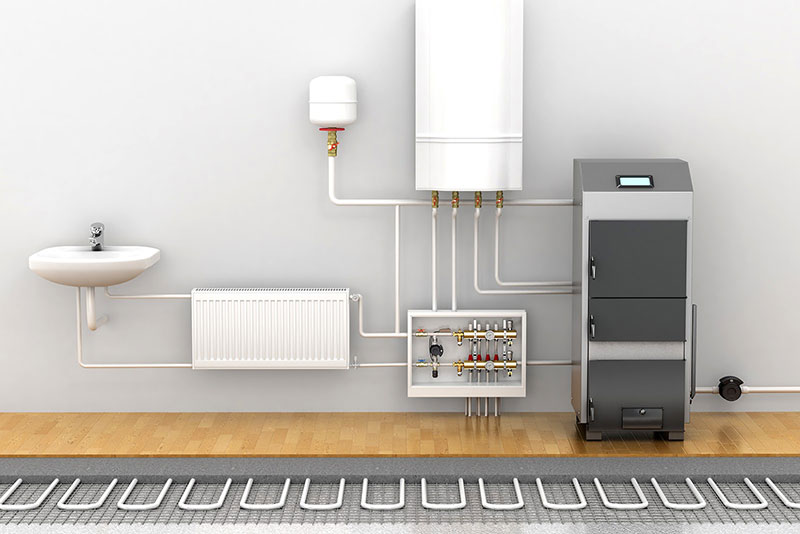As you start to plan the replacement of your current water heating unit, it is important to have a clear idea of the costs involved whether you go with a traditional tank or the tankless units.
One of the main reasons tank options are still viable is due to the ease with which they can be installed in your home and the large availability of different models. This makes them the most budget-friendly option for water heater replacement currently available.
While there are a number of factors that go into the pricing of an installation and replacement (we’ll get into those later), the general rate for most replacements of tank hot water heaters is around the $2000 mark.
At Pink Plumbing, the standard cost of removing, installing, and replacing your water heating unit with a quality 50 gallon gas-fueled water heater (adequate for a 4-person family) is $2,300 CAD.
This includes the cost of the new unit, the site inspection, any necessary permits, the labor, and – most importantly – a 6-year warranty program from Waterline. Furthermore, call-in fees are removed for our clients that service with us, saving you money on the regular maintenance of your unit.
Read more about our standard hot water replacement/installation service.
What are the various factors that can affect the price of your hot water heater replacement?
Fuel source
The fuel source of choice for your new water heater is directly related to its cost. Firstly, electric and gas models of tank water heaters are priced differently, with electrical units typically up to $300 cheaper than their gas alternatives. In terms of initial investment, this can make electric tank water heaters more attractive to potential buyers.
Electric tank water heaters are also desirable because they do not require venting: if you’re installing the first water heater in a newly-built home, electric will not require you to drill any additional holes into your wall.
Gas water heaters – while being more expensive on the initial purchase – have their fair share of savings: for one, it is generally cheaper to run your water heater with gas due to the cost of electricity. The $300 extra will quickly become paid off after a few years of ownership simply in the utility bill savings.
Gas water heaters also require venting: having a gas-fueled unit installed can become more expensive as it involves opening up walls and creating space for ventilation ducts. It’s also important to remember that if the new water heater you’re buying operates on a different fuel source than your previous one, there may be additional costs involved with making the switchover: is your current electricity intake adequate? Do bigger gas lines need to be installed? All these questions can be answered by your trusted water heater technician.
Capacity
The size and capacity of your tank water heater will dictate cost. Past the obvious fact that a bigger tank will be more expensive than its smaller counterparts, it is also important to remember that the size of your new tank will affect what labor needs to happen during the installation.
If you are replacing your water heater with a bigger one because the previous one did not meet changes in your water demand, you need to ensure that the new unit will fit properly where the old one was. If your 40-gallon unit fit snugly in the basement and you wanted to install a 60-gallon tank, will additional space need to be made to house your new unit? If so, you may be looking at carpentry labor, drywall, and more. If your new water heater won’t fit where the previous one did, will you have to run new electrical and gas lines to the spot where the new one is getting installed?
Venting style
If you’re installing a gas-fueled tank water heater in your home, you’ll need to have the appropriate venting for exhaust gasses. If you were already running a gas-fueled unit as your old water heater, then there’s no additional work that needs to be done. If you’re switching from electric to gas however, ventilation ducts will need to be installed in your home. This means walls may need to be opened up to create space for the ducts.
There are also two kinds of ventilation for gas-fired water heaters: direct and power. Direct is when the exhaust gasses are removed from the house through a flue pipe located above the unit and the install can be up to $1000 to accommodate for the extra labor. Power venting is when an electric fan is installed to actively force exhaust vapors from the water heater – this gives homeowners more flexibility with where they can install venting and has higher energy efficiency. The cost is often a few hundred dollars more than a direct vent, however.
Removal
The water heater technician’s ability to remove your old tank will also be a factor in the price of installing your new unit. The size of the unit and its accessibility in your home will affect how long it will take to unplug and safely remove the water heater. Will a bunch of appliances need to be moved? Is the old water heater extremely heavy? In the final labor cost, the removal of the old unit will have a bearing if it is cumbersome or not easily transported.
Labor time
All of the above factors play into the final cost of labor for your new water heater. For some installs, there isn’t more to be done than removing the old water heater and putting the new one in. For many, no new cables will need to be laid, no new pipes or water hookups need to be installed, and the new water heater will be in your house as easily as the last one left.
However, switching to a new fuel source will have some extra costs involved in terms of ventilation, cabling, and more. Additional materials like solder and anti-corrosion ventilation pipes can make install costs higher. Switching to a larger unit might mean some carpentry work needs to be done for it to fit where all the hookups are, with framing being a common necessity. Getting a high-draw electrical unit could involve dialogue with your energy provider and potentially require new cables to accommodate. Changing where in the house your water heater is will involve significantly longer labor times for the extension of fuel and water lines.
All of these factors will dictate whether or not additional specialists need to be a part of the install process, like electricians, drywall installers, framers, and more.
If you have any questions about what the cost of tank water heater replacement might look like in your home and for your specific situation, do not hesitate to call Pink Plumbing to speak to one of our technicians today.



